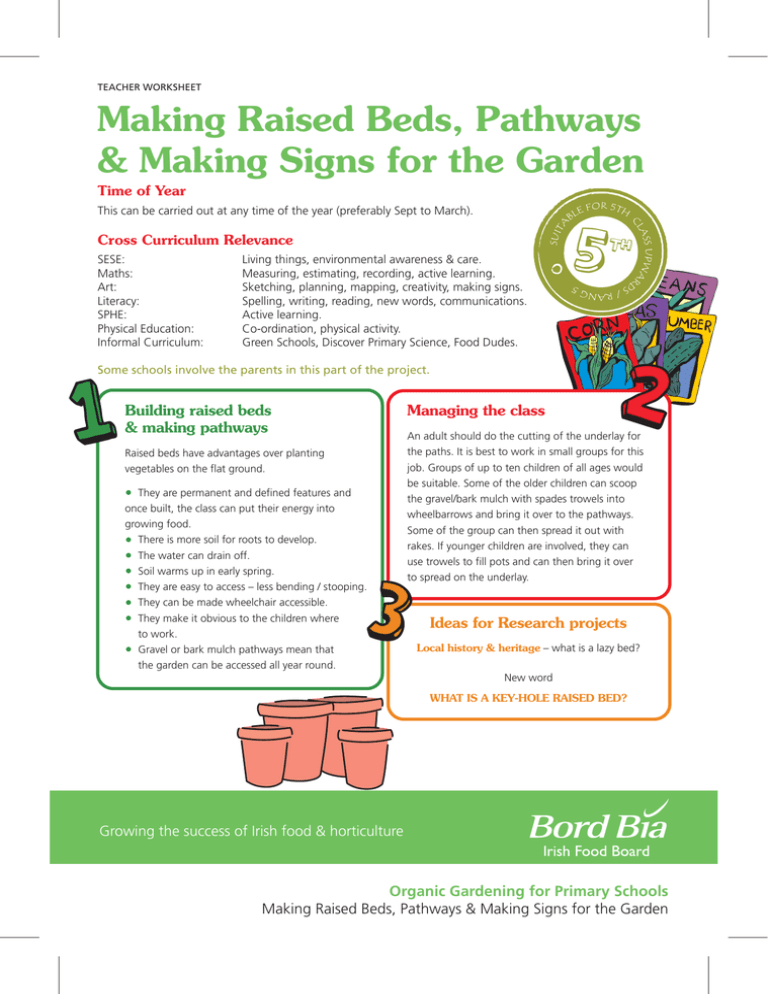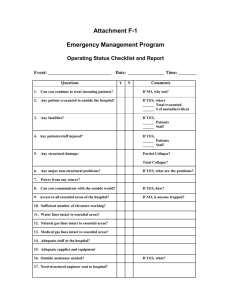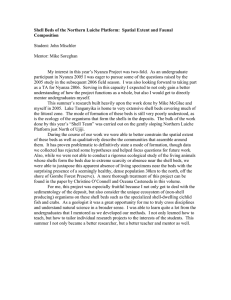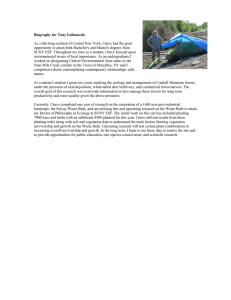Making Raised Beds, Pathways & Making Signs for the Garden
advertisement

TEACHER WORKSHEET Making Raised Beds, Pathways & Making Signs for the Garden Time of Year A SUIT 5 th / RANG 5 Living things, environmental awareness & care. Measuring, estimating, recording, active learning. Sketching, planning, mapping, creativity, making signs. Spelling, writing, reading, new words, communications. Active learning. Co-ordination, physical activity. Green Schools, Discover Primary Science, Food Dudes. UPWA R SESE: Maths: Art: Literacy: SPHE: Physical Education: Informal Curriculum: OR 5T H EF ASS CL Cross Curriculum Relevance BL DS This can be carried out at any time of the year (preferably Sept to March). Some schools involve the parents in this part of the project. Building raised beds & making pathways Raised beds have advantages over planting vegetables on the flat ground. • They are permanent and defined features and once built, the class can put their energy into growing food. • There is more soil for roots to develop. • The water can drain off. • Soil warms up in early spring. • They are easy to access – less bending / stooping. • They can be made wheelchair accessible. • They make it obvious to the children where • to work. • Gravel or bark mulch pathways mean that • the garden can be accessed all year round. Managing the class An adult should do the cutting of the underlay for the paths. It is best to work in small groups for this job. Groups of up to ten children of all ages would be suitable. Some of the older children can scoop the gravel/bark mulch with spades trowels into wheelbarrows and bring it over to the pathways. Some of the group can then spread it out with rakes. If younger children are involved, they can use trowels to fill pots and can then bring it over to spread on the underlay. Ideas for Research projects Local history & heritage – what is a lazy bed? New word WHAT IS A KEY-HOLE RAISED BED? Growing the success of Irish food & horticulture Organic Gardening for Primary Schools Making Raised Beds, Pathways & Making Signs for the Garden TEACHER WORKSHEET Making Raised Beds, Pathways & Making Signs for the Garden contd. Aim To build a series of raised beds for the school vegetable and flower garden. • • • • • • • • This is usually a minimum of 4 beds to allow rotation of the main vegetable families. Some schools have a bed for each class in the school. The vegetable area should be in a sunny part of the school as this will be warmer and not at the bottom of a slope, in a wet patch or in the shadow of dark evergreen trees. If you have made a plan of the school grounds you will have a good idea of where the best location is. Some schools make a fence (wooden/paling or from living willow) to screen the vegetable area from the school yard or football pitch. This can always be done later. Make at least one bed, 1m/3ft high as a wheelchair accessible bed – this bed can be 3 planks high. How to make the raised beds Raised Bed Patterns - Options • • • • • • • • • • • • Option 1: Sun-shaped raised beds – these have a bed in the centre that is hexagonal shaped and 8 beds radiating out – these can be full length or split for easier access (as seen in Donaghmede school garden on the DVD). Plan the bed design. Measure out the lengths of wood needed. Cut them to size and nail them together. Place a layer of wet cardboard or newspaper at the bottom as it helps kill off existing grass (this is optional). Fill with alternating layers of manure/compost and top soil or soil that you are digging from around the bed to make the paths. Do not dig too deep as the paths may puddle with water. You can build up more fertility in the beds over the years by adding compost. Option 2: Raised beds in regular lines and shapes. This can suit school gardens that are going to be on a slope (as seen on the Ardee school on the DVD). Option 4: Key-hole raised beds – these are beds that have access to the centre through a central pathway and mean that you have access to all sides from the centre of the bed. The sides can be built with timber also. NOTES: • Like everything in gardening, your site will decide • which is the most suitable way to build your beds. • The general guide is that if you do not have much • soil then you can construct the wooden • framework, then add the layers. You will need • to bring in more top soil, manure/compost. Growing the success of Irish food & horticulture Organic Gardening for Primary Schools Making Raised Beds, Pathways & Making Signs for the Garden TEACHER WORKSHEET Making Raised Beds, Pathways & Making Signs for the Garden Resources needed to make raised beds Timber You can use old scaffolding or scrap wood, or if you are buying the wood try to get timber that has not been treated with chemicals. The amount you need will depend on how many beds and the size you want them to be – it is a good idea to make the beds no wider than 1-1.5 metres so they can be accessed from both sides easily. An example of a suitable plank size would be 23cm height x 5cm thick. There is always the option of making a key-hole bed, which is a large bed that has access to the middle through making a ‘key-hole shape’. If you are digging out the soil (like traditional lazy beds) you will need; • Twine and twigs to mark off the beds. • Measuring tapes to measure lengths. • Wheelbarrows. • Top soil (not always necessary). • Spades, shovels and trowels. • Trailer load of manure/seaweed • (from a parent or local farmer/horse stable) • and wet paper or cardboard (optional). • 10cm nails and hammer, handsaw. • Gloves. • Black plastic or cardboard & straw /manure • /seaweed/compost to cover the bed with if it • is not being planted - acts as a mulch to keep • weeds down. contd. How to make the pathways • • • • • • • • • • • • • Make sure they are a minimum width of 1m for wheelchair and wheelbarrow accessibility. Ensure the ground is as level as possible before laying pathways. Lay the underlay down on the pathways and cut to fit the width and length of the space. Push edges under the edges of the wood of the raised beds. This will help prevent the weeds growing up at edges of beds. Cover with 5 -10cm of gravel or bark mulch. This can be done with the younger classes with pots/yoghurt cartons, trowels and gloves and wheelbarrows. Resources needed to make pathways Pathways can be laid with a variety of materials such as gravel and bark mulch. • • • • • • • • Trailer load of gravel or bark mulch or straw. Underlay for gravel (this can be recycled old carpets, moypex or geo-textile fleece). Shovels or spades & rake. Wheelbarrows. Gloves. Pots/yoghurt cartons, trowels – for the junior classes. Growing the success of Irish food & horticulture Organic Gardening for Primary Schools Making Raised Beds, Pathways & Making Signs for the Garden TEACHER WORKSHEET Making Raised Beds, Pathways & Making Signs for the Garden contd. Making signs for the garden Resources needed to make signs This is one of the most important projects from an educational aspect. Signs communicate the food, plants & habitats in the garden and transform the space into a Living Classroom. Recycle waste materials as much as possible (can be part of the Green School Recycling Project) If you want to spend money on getting signs made, prioritise the permanent features & habitats in the garden. The vegetables, herbs and flowers can be done on an annual basis as part of art, literacy and communications. • • • • • • Slate or wood or plastic sheets. Timber to make posts to mount the signs. Nails & hammer or screws & drill. Paint/paint brushes (can also use chalk but will wash away). Non-toxic varnish to make the signs water proof. Fruit & Vegetables Growing the success of Irish food & horticulture Organic Gardening for Primary Schools Making Raised Beds, Pathways & Making Signs for the Garden





